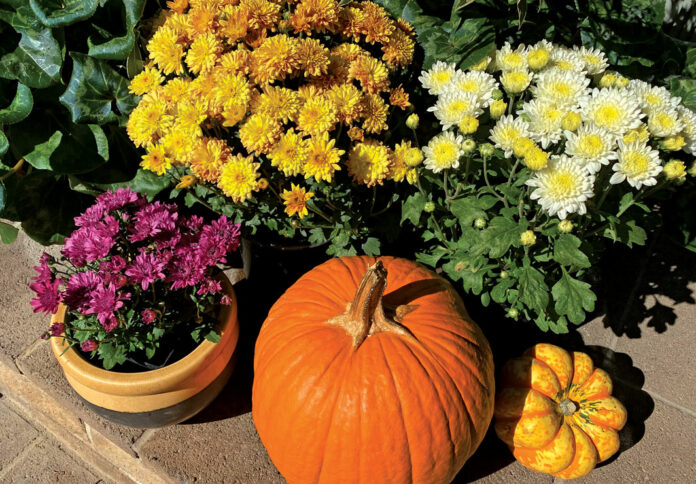It’s beginning to look like Halloween in my neighborhood with chrysanthemums and pumpkins on porches, skeletons and ghouls decorating front doors and posts on Facebook about tarantula sightings as the spiders go about their fall mating ritual. It’s the plants that get my attention though.
If you want to decorate for Halloween there is plenty of plant material you can harvest from your own garden or nearby woods. Manzanita branches can often be found on the ground and make great arrangements combined with nandina or other berries. Some of the trees have started to turn color and their leaves can also be used for wreaths. The leaves of New Zealand flax last a long time and add fall color in bouquets.
Chrysanthemums are so common we often think of them as temporary filler plants in fall containers and borders. But mums are perennials and can play a bigger role in your garden if you let them. Chrysanthemums were first cultivated in China as far back as the 15th century. Over 500 cultivars had been recorded by the year 1630. There are records in Japan from the 8th century relating to mums.
Grown for years to flower only in late summer and fall, they are short day plants, setting buds when they receive light for 10 hours and darkness for the other 14 hours of the day. This is why mums bloom in the spring on leggy stems if they are not cut back. And this is how growers manipulate their blooming, adjusting the dark and light periods with shades in the greenhouse so buds will form in any month. They’re nearly constantly available in grocery stores and florists in every season.
Choose a well-drained, sunny spot to plant mums. Like many members of the aster family, mums won’t tolerate soggy ground. After blooming, trim off the old flowers and cut back plants to within 4 or 5 inches of the ground. If you started with 4-inch pots, trim back by half.
Many tough perennials don’t require a lot of water once established. I like the bright flowers of Gloriosa Daisy or Black-eyed Susan (rudbeckia). These perennials are outstanding cut flowers, tough and easy to grow. They are descended from wild plants native to the eastern U.S. but require only moderate water once established. Daisy-like flowers are not attractive to deer either. Rudbeckia bloom throughout the summer and into fall. Butterflies, bees and other insects are attracted to the flowers for the nectar. As they collect nectar, they move pollen from one plant to another.
As members of the composite family Coneflowers (echinacea) have a flat landing surface for butterflies to land on. Coneflowers are one of my favorites. When they start blooming in the early summer I enjoy them both in the garden and as cut flowers inside. Some have a slight fragrance. Hybridizers have introduced beautiful shades of gold, yellow, orange, burgundy and coral in addition to the traditional purple and pure white. Because they are dormant in the winter they are good candidates for the garden that has summer sun but winter shade. They are not attractive to deer and are good additions to the low water garden. The clumps spread slowly and can be carefully divided after three or four years. If faded flowers are left in place, the bristly seed heads provide food for finches in winter.
The herb echinacea is derived from varieties of this flower. Echinacea purpurea and other varieties are used as a fortifier of the immune system, mainly to prevent flu and minor respiratory diseases by increasing the body’s production of interferon. The roots are the part of this plant used for medicinal purposes.
Echinacea was used by Native Americans more than any other plant in the Plains. It was used to treat snake and insect bites because of its antiseptic properties and to bathe burns. They chewed the plant roots to ease the pain of a toothache. It was also used for purification. The leaves and the flowers can be used in teas as well.
Some other perennials to try are agastache or Hummingbird mint. Plant near your organic edible garden to provide nectar for pollinators as well as hummingbirds. The flowers are edible as a salad garnish, in baked goods and in cocktails while their foliage can be added to herb salads or in a cup of tea.
Jan Nelson, a landscape designer and California-certified nursery professional, will answer questions about gardening in the Santa Cruz Mountains. Email her at ja******@*ol.com, or visit jannelsonlandscapedesign.com.









